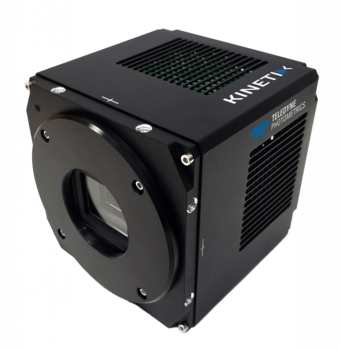Dynamic Microfluidic Imaging
Dr. Georg Krainer, Dr. William Arter, Prof. Tuomas Knowles
Yusuf Hamied Department of Chemistry, University of Cambridge
Background
The Knowles Lab at the University of Cambridge is an interdisciplinary group that develops new approaches to probe the behavior of biological molecules, especially protein self-assembly, a process that can result in several neurodegenerative diseases when misfolding occurs.
Dr. Georg Krainer and Dr. William Arter of the Knowles lab use custom-developed microfluidic platforms to study these proteins, investigating the fundamental molecular level events that drive proteins to convert from their normal soluble forms into aberrant aggregates. These experimental platforms require integration into advanced multichannel optics for imaging across different fluorophores, as the moving fluid droplets are labeled with several different fluorescent markers.

Figure 1: An image taken with the Kinetix CMOS paired to a Cairn MultiSplit, showing 4 separate wavelengths simultaneously from droplets in a microfluidic device moving under flow. The left image shows the raw 4-way split across the Kinetix sensor, and the right shows the 4 channel composite.
Challenge
Dr. Krainer and Dr. Arter outlined some of the challenges of their setup: "We are integrating optics with microfluidics so the main challenge is getting stable images of molecules under flow as they move through the field of view, for that we need a high speed camera to get crisp images."
The high speed imaging also needs to be performed across a large field of view (FOV) and for several different fluorescent channels, requiring the use of a large area CMOS that can be reliably paired with an image splitter.
They also mentioned the need for sensitivity, "We are dealing with a low signal so we are interested in a high sensitivity option."
The large sensor and high speed of the Kinetix allow us to do full FOV imaging with a splitter across three fluorescent channels and one brightfield channel simultaneously, this is really what we need for our application.
Dr. Georg Krainer
Solution
Delivering a large sensor, high speed and high sensitivity, the Kinetix is the next step in CMOS camera technology. The large 29.4 mm sensor of the Kinetix matches up well to image splitters, especially the Cairn MultiSplit, splitting a Kinetix sensor 4 ways still results in a diagonal FOV of 15 mm per quadrant.
Dr. Arter told us about his experience with the Kinetix, "The large sensor of the Kinetix allows us to do full FOV imaging with a splitter from Cairn Research [MultiSplit] we can image three fluorescence channels and one brightfield channel simultaneously on one single chip, instead of needing multiple cameras, and this is really what we need in our application."
The large FOV and high speed of the Kinetix enable experiments that were not possible before, in this case, high-quality multicolour imaging of droplets under flow with a single sensor, with some systems built with the Kinetix in mind, as Dr. Krainer says, "The Kinetix platform offered us excellent possibilities for multiplexed imaging together with the MultiSplit. We needed a large field of view and we needed simultaneous multichannel imaging with fluorescence and brightfield, it is the perfect combination... We also got great support from [Teledyne] Photometrics in setting up the Kinetix, the team was very helpful."
